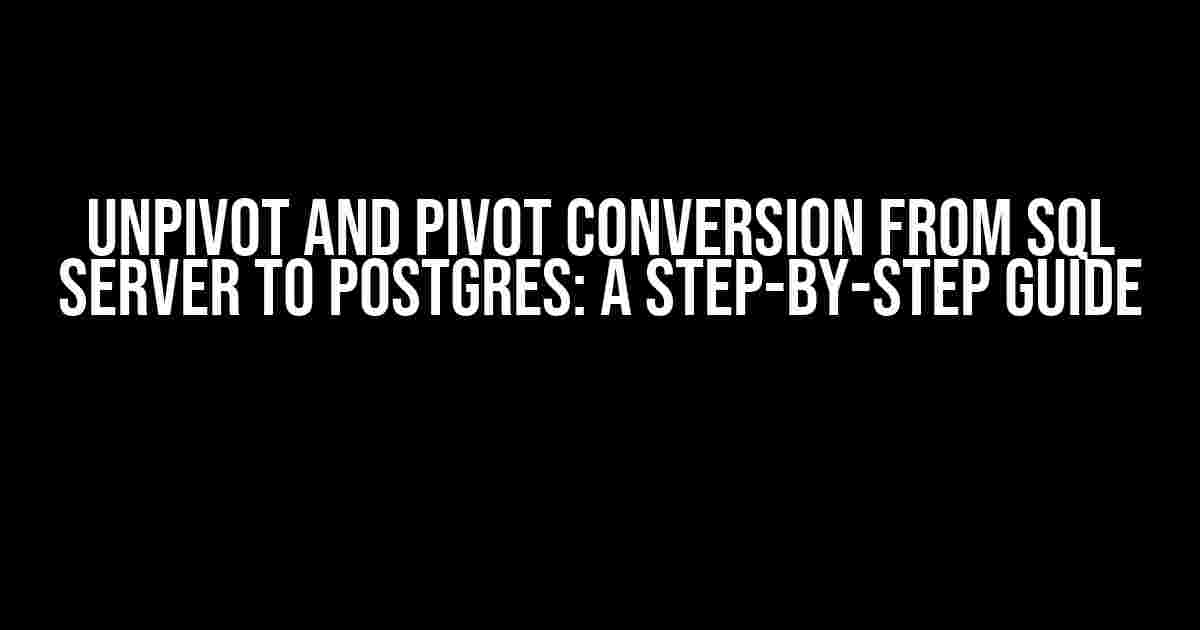Are you tired of dealing with the complexities of SQL Server and looking to make the switch to Postgres? One of the most critical aspects of this conversion is handling unpivot and pivot operations. In this article, we’ll walk you through the process of converting unpivot and pivot queries from SQL Server to Postgres, ensuring a seamless transition and optimal performance.
Understanding Unpivot and Pivot Operations
Before diving into the conversion process, let’s quickly review what unpivot and pivot operations entail:
Unpivot Operation
An unpivot operation transforms columns into rows, making it easier to analyze and manipulate data. For example, consider a table with columns for different regions and their corresponding sales figures:
| Region | Q1 Sales | Q2 Sales | Q3 Sales | Q4 Sales |
|---|---|---|---|---|
| North | 100 | 120 | 110 | 130 |
| South | 90 | 100 | 95 | 105 |
| East | 80 | 90 | 85 | 95 |
| West | 70 | 80 | 75 | 85 |
An unpivot operation would transform this table into:
| Region | Quarter | Sales |
|---|---|---|
| North | Q1 | 100 |
| North | Q2 | 120 |
| North | Q3 | 110 |
| North | Q4 | 130 |
Pivot Operation
A pivot operation does the opposite, transforming rows into columns. Using the previous example, a pivot operation would transform the unpivoted table back into the original format:
| Region | Q1 Sales | Q2 Sales | Q3 Sales | Q4 Sales |
|---|---|---|---|---|
| North | 100 | 120 | 110 | 130 |
Converting Unpivot Queries from SQL Server to Postgres
Now that we’ve covered the basics of unpivot and pivot operations, let’s dive into converting unpivot queries from SQL Server to Postgres:
SQL Server Unpivot Query
SELECT Region, Quarter, Sales FROM ( SELECT Region, [Q1 Sales], [Q2 Sales], [Q3 Sales], [Q4 Sales] FROM SalesTable ) AS SourceTable UNPIVOT ( Sales FOR Quarter IN ([Q1 Sales], [Q2 Sales], [Q3 Sales], [Q4 Sales]) ) AS UnpivotedTable;
Postgres Unpivot Query
In Postgres, we can use the `unnest` function in conjunction with `transpose` to achieve the same result:
SELECT Region, Quarter, Sales
FROM (
SELECT Region,
unnest(array['Q1 Sales', 'Q2 Sales', 'Q3 Sales', 'Q4 Sales']) AS Quarter,
unnest(array[Q1_Sales, Q2_Sales, Q3_Sales, Q4_Sales]) AS Sales
FROM SalesTable
) AS SourceTable;
Note that in Postgres, we need to use the `unnest` function to split the arrays into individual rows, and then use the `transpose` function to pivot the data.
Converting Pivot Queries from SQL Server to Postgres
Now, let’s convert pivot queries from SQL Server to Postgres:
SQL Server Pivot Query
SELECT Region, [Q1 Sales], [Q2 Sales], [Q3 Sales], [Q4 Sales] FROM ( SELECT Region, Quarter, Sales FROM SalesTable ) AS SourceTable PIVOT ( SUM(Sales) FOR Quarter IN ([Q1 Sales], [Q2 Sales], [Q3 Sales], [Q4 Sales]) ) AS PivotedTable;
Postgres Pivot Query
In Postgres, we can use the `crosstab` function to pivot the data:
SELECT * FROM crosstab( 'SELECT Region, Quarter, Sales FROM SalesTable', 'SELECT DISTINCT Quarter FROM SalesTable ORDER BY 1' ) AS ( Region text, "Q1 Sales" numeric, "Q2 Sales" numeric, "Q3 Sales" numeric, "Q4 Sales" numeric );
Note that in Postgres, we need to use the `crosstab` function to pivot the data, and then specify the column names and data types in the output.
Best Practices for Unpivot and Pivot Conversions
To ensure a smooth transition from SQL Server to Postgres, follow these best practices for unpivot and pivot conversions:
- Test your queries thoroughly to ensure accurate results.
- Optimize your queries for performance, especially when dealing with large datasets.
- Use consistent naming conventions and formatting throughout your queries.
- Document your conversions and provide clear explanations for future reference.
- Consider using views or stored procedures to encapsulate complex logic.
Conclusion
Converting unpivot and pivot queries from SQL Server to Postgres requires a solid understanding of the underlying data and the syntax differences between the two databases. By following the step-by-step guide and best practices outlined in this article, you’ll be well on your way to a successful conversion.
Remember to test your queries thoroughly and optimize for performance to ensure a seamless transition. With the right approach and knowledge, you can unlock the full potential of Postgres and take your data analysis to the next level.
Additional Resources
For further learning and reference, check out these additional resources:
- Postgres Array Functions
- Postgres Table Functions
- Postgres Crosstab Function
- SQL Server Pivot and Unpivot
Frequently Asked Question
Get ready to unravel the mysteries of unpivot and pivot conversion from SQL Server to Postgres!
What is unpivoting in SQL, and how does it differ from pivoting?
Unpivoting is a process that transforms data from a wide format to a narrow format, whereas pivoting does the opposite. Think of it like rotating a table: unpivoting rotates the data from columns to rows, and pivoting rotates it from rows to columns. In SQL Server, you can use the UNPIVOT function to achieve this. In Postgres, you can use the crosstab function from the tablefunc extension.
How do I unpivot a table in SQL Server?
You can use the UNPIVOT function in SQL Server to unpivot a table. The basic syntax is: SELECT




